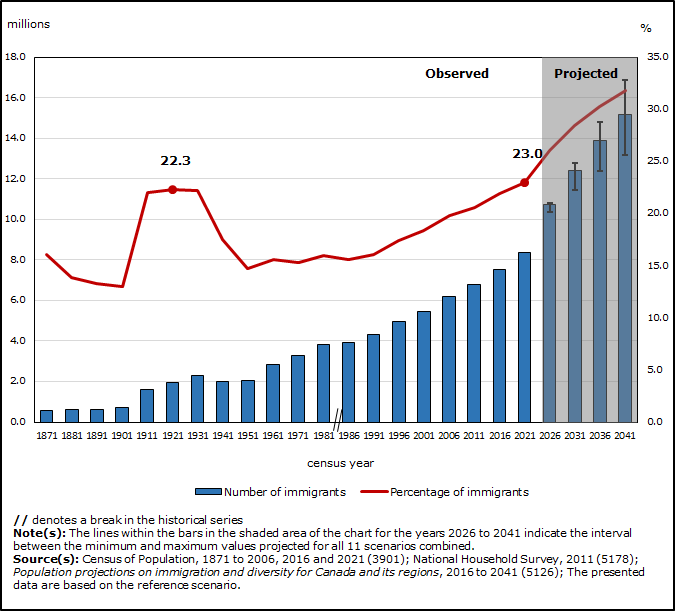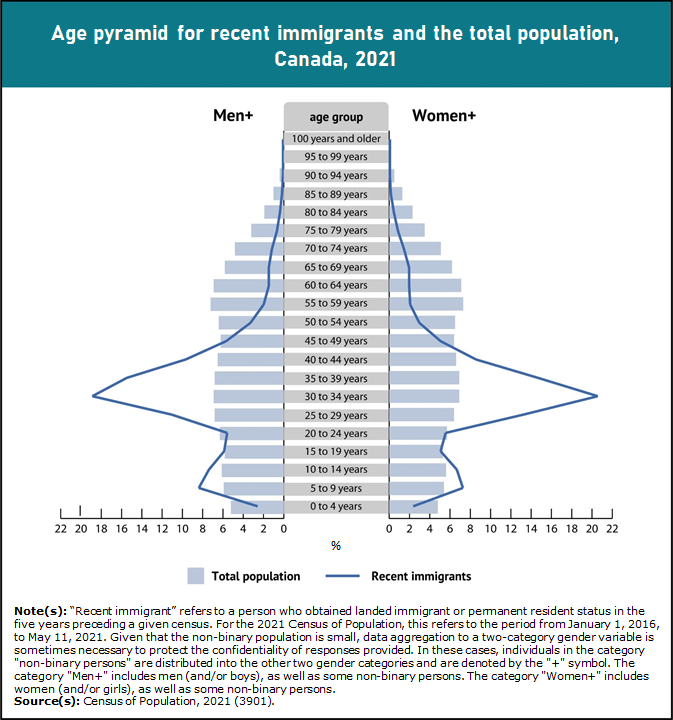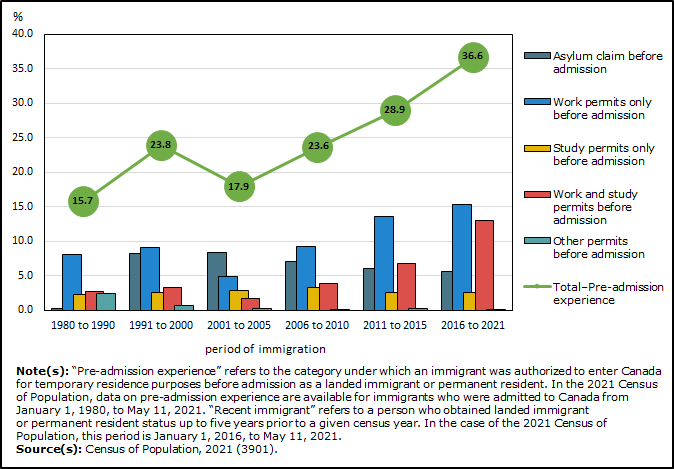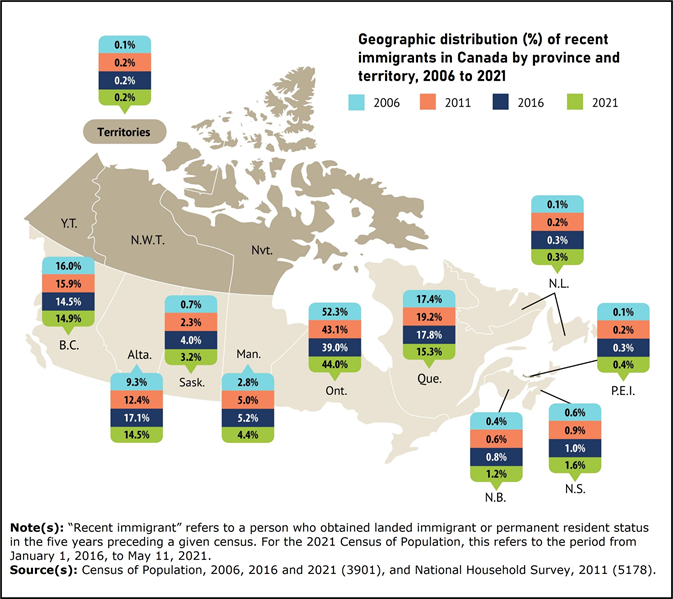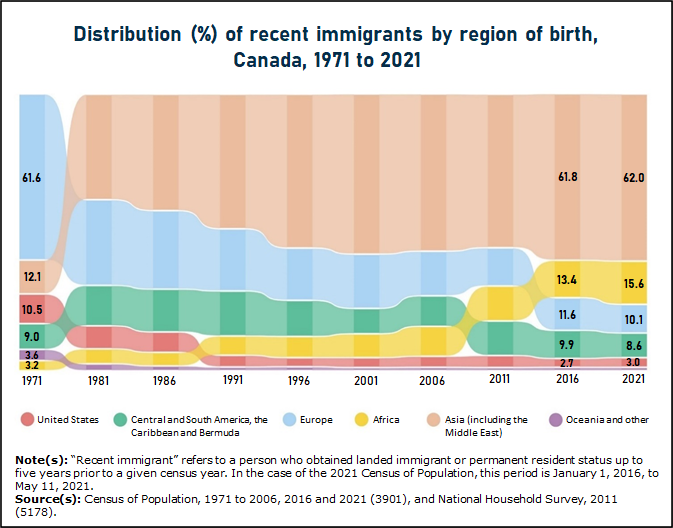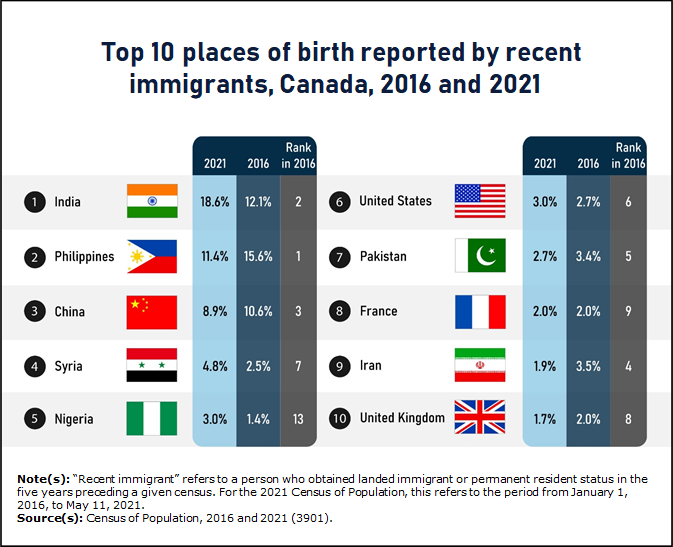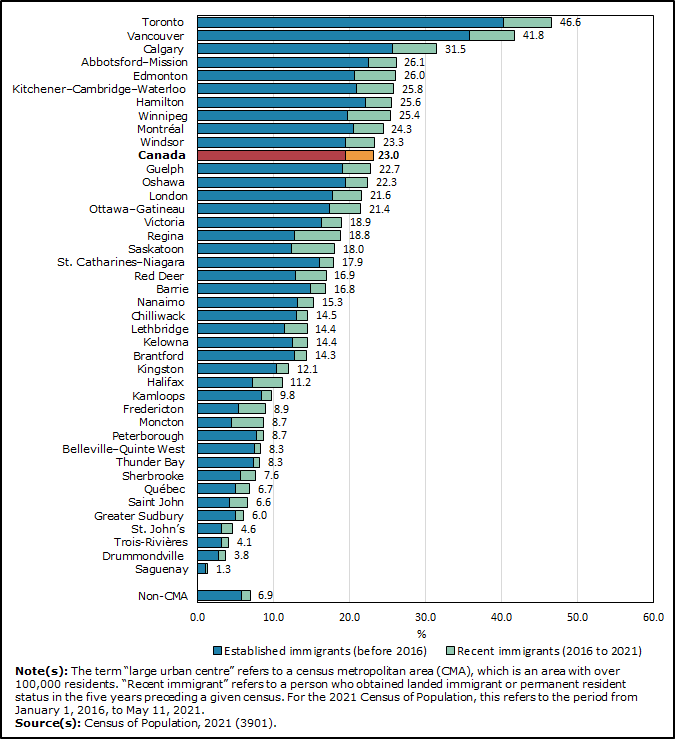Immigrants make up the largest share of the population in over 150 years and continue to shape who we are as Canadians
Released: 2022-10-26
Canada has a long history of immigration. Millions of people from all over the world have chosen, and continue to choose, Canada as their new home. In 2021, more than 8.3 million people, or almost one-quarter (23.0%) of the population, were, or had ever been, a landed immigrant or permanent resident in Canada. This was the largest proportion since Confederation, topping the previous 1921 record of 22.3%, and the highest among the G7.
Given that the population of Canada continues to age and fertility is below the population replacement level, today immigration is the main driver of population growth. If these trends continue, based on Statistics Canada's recent population projections, immigrants could represent from 29.1% to 34.0% of the population of Canada by 2041.
The COVID-19 pandemic highlighted the contribution that immigrants make to Canada's labour market. With job vacancies in late 2021 hitting 80% higher than pre-pandemic levels, and the working population aging, immigration is even more critical to the labour market than ever before. Recent immigrants, whose age structure is younger than the general population, constitute a pool of workers who can help mitigate the impacts of labour shortages in a number of sectors and regions across the country. From 2016 to 2021, immigrants accounted for four-fifths of labour force growth. More and more immigrants have pre-admission experience in Canada, and a large share of recent immigrants were selected for their ability to contribute to Canada's economy.
Immigrants come from many different countries, bringing with them their cultural, ethnic, linguistic and religious heritage. In the past, the majority of immigrants in Canada came from Europe. However, over the past 50 years, the share of new immigrants from Europe has declined, with the share of new immigrants who were born in Asia (including the Middle East) increasing. Over time, Asia has become the top source region of new immigrants, and this trend continued in 2021. The share of new immigrants from Africa also increased. Together, immigrants, Indigenous people—who have walked this land for thousands of years, before Europeans settled here—and their descendants have helped shape Canada as it is known today.
Today, Statistics Canada is releasing the sixth set of results from the 2021 Census, which provide an updated statistical portrait of the immigrant population. The census is one of the most comprehensive sources of data on immigrants living in Canada, allowing for comparability over time and at various levels of geography.
Governments at all levels—from federal to provincial, territorial and municipal—as well as many other non-governmental and community organizations will use this information to develop and evaluate immigration policies and programs, and to plan and implement education, health care, housing and other services.
Highlights
Almost one in four people (23.0%) counted during the 2021 Census are or have been a landed immigrant or permanent resident in Canada. This was the highest proportion since Confederation, topping the previous record of 22.3% in 1921, and the largest proportion among G7 countries.
Just over 1.3 million new immigrants settled permanently in Canada from 2016 to 2021, the highest number of recent immigrants recorded in a Canadian census.
The share of recent immigrants settling in Atlantic Canada almost tripled in 15 years, rising from 1.2% in 2006 to 3.5% in 2021.
Over half of recent immigrants living in Canada were admitted under the economic category. Of these 748,120 economic immigrants, just over one-third (34.5%) were selected through skilled worker programs and another one-third (33.6%) through the Provincial Nominee Program.
The proportion of immigrants who first came to Canada temporarily on work or study permits or as asylum claimants before being admitted as permanent residents was especially high among recent immigrants who settled since 2016 (36.6%).
Asia, including the Middle East, remained the continent of birth for most recent immigrants (62.0%).
Almost one in five recent immigrants (18.6%) were born in India, making it the leading country of birth for recent immigration to Canada.
In contrast, the share of recent immigrants from Europe continued to decline, falling from 61.6% in 1971 to 10.1% in 2021.
The vast majority (92.7%) of recent immigrants are able to conduct a conversation in either English or French.
The share of second-generation Canadians (children of immigrants) younger than 15 years with at least one foreign-born parent rose from 26.7% in 2011 to 31.5% in 2021.
Canada's population growth driven by the record number of new immigrants admitted from 2016 to 2021
The rising proportion of immigrants is mainly driven by the record number of new immigrants who came to Canada from 2016 to 2021, despite fewer immigrants being admitted in 2020 because of the border and travel restrictions implemented in response to the pandemic.
From 2016 to 2021, Canada's population living in private households grew by 5.4%, and new, or recent, immigrants accounted for 71.1% of that growth.
Over 1.3 million recent immigrants were permanently admitted from January 1, 2016 to May 11, 2021, accounting for 15.9% of all immigrants living in Canada in 2021.
When combined with those already established here, more than 8.3 million people, or 23.0% of the population, were or had ever been a landed immigrant or permanent resident of Canada in 2021.
Immigration is expected to continue to increase in the decades to come. According to Statistics Canada's recent population projections, immigrants could represent from 29.1% to 34.0% of the total population by 2041.
Close to two-thirds of recent immigrants are of core working age
While Canada has the highest share of the total population aged 15 to 64 among G7 countries, at 64.8%, the country's working population has never been older. According to the recent census release on age and type of dwelling, more than one in five people were closing in on retirement age (55 to 64 years), an all-time high. There were also more people aged 55 to 64 than young adults aged 15 to 24.
While immigration ultimately cannot stop the population aging process, it has a rejuvenating effect on the population in Canada overall. Since people usually migrate when they are young, the vast majority (95.8%) of recent immigrants to Canada from 2016 to 2021 were under the age of 65.
Just over 1 in 10 recent immigrants were youth and young adults aged 15 to 24 (10.9%), while most (64.2%) were in the core working age group of 25 to 54. A much smaller proportion of recent immigrants (3.6%) were aged 55 to 64.
Children younger than 15 years of age, who may one day join the labour force, represented 17.1% of recent arrivals to Canada. Immigration over the near term will ease the labour force crunch in Canada.
More immigrants are now working in Canada than before the pandemic, and, from 2016 to 2021, immigration contributed to 79.9% of the growth in Canada's labour force. The labour market outcomes of immigrants have improved in recent years, and since 2016, the employment rate among immigrants has risen by 2.0 percentage points, while the Canadian-born population has experienced a decrease of 2.0 percentage points.
Although more immigrants are employed in Canada, challenges remain, especially regarding skill utilization. From 2001 to 2016, the percentage of university-educated recent immigrants working in a job requiring a university degree decreased and was well below the proportion of their Canadian-born counterparts. Recent policy changes have been implemented to improve labour market outcomes for new immigrants and to increase the responsiveness of immigration to labour market demand. The census release in November 2022 will allow for further analysis of the education levels of Canada's recent immigrants and their skill uptake in the labour market.
More than half of recent immigrants are admitted under the economic category
In Canada, immigrants are selected according to three broad objectives: to enhance and promote economic development, to reunite families, and to fulfill the country's international obligations and uphold its humanitarian tradition.
Immigrants admitted under the economic category are selected based upon their potential economic contribution to meet labour market needs, or to create economic opportunities by owning, operating or investing in a business or through self-employment. In 2021, more than half (56.3%) of recent immigrants living in Canada were admitted under the economic category, either as the principal applicant or the dependant.
Among the broad types of economic immigration programs, more than one-third (34.5%) of new economic immigrants admitted from 2016 to 2021 were selected under one of the skilled worker programs. A similar proportion were selected under the Provincial Nominee Program, which is a program where people who have skills, education and work experience are nominated to contribute to the economy of a specific province or territory.
The proportion of economic immigrants admitted under the Provincial Nominee Program has increased since the first Provincial Nominee Program agreement was signed in Manitoba in 1996. Of those new economic immigrants admitted from 2016 to 2021, 33.6% were Provincial Nominee Program candidates, compared with 3.7% of those economic immigrants admitted from 2001 to 2005 and still living in Canada.
Manitoba (90.2%) had the highest share of recent economic immigrants selected as provincial nominees, followed by Saskatchewan (87.3%) and Prince Edward Island (84.7%). Provincial nominees also accounted for the majority of recent economic immigrants in Nova Scotia (66.4%), New Brunswick (63.7%), Yukon (62.9%), the Northwest Territories (56.8%) and Newfoundland and Labrador (53.3%).
In Canada, nine provinces and two territories have established their own Provincial Nominee Program. The exceptions are Quebec and Nunavut. Quebec has administered its own economic immigration programs since 1991 through the Canada–Quebec Accord, which gives the province more autonomy over the selection and integration of its immigrants. In 2021, 46.4% of recent immigrants who lived in Quebec were admitted under a skilled worker program.
Just under 61,000 recent refugees came from Syria, attesting to Canada's international commitments and its long-standing humanitarian tradition
According to the 2021 Census, there were 218,430 new refugees admitted as permanent residents from 2016 to 2021 and still present in Canada at the time of the census. The primary places of birth of refugees have changed considerably over the decades, in tandem with conflicts and international events. These changes are reflected in the profile of refugees who are still in the country today.
For example, from 1980 to 1990, most refugees came from Viet Nam, Poland and El Salvador.
From 1991 to 2000, Sri Lanka, Bosnia and Herzegovina and Iran accounted for the largest share of refugees admitted to Canada.
From 2001 to 2010, Colombia, Afghanistan and Iraq were the main countries of birth of refugees who settled in Canada during that period.
In 2015, the Government of Canada committed to bringing Syrian refugees to the country. At the time of the 2016 Census, close to 27,000 Syrian refugees had already been admitted to Canada over the previous five years. From 2016 to 2021, 60,795 new Syrian-born refugees were admitted and living in Canada, accounting for over one-quarter (27.8%) of the new refugees in the country.
Iraq (15,505), Eritrea (13,965), Afghanistan (9,490) and Pakistan (7,810) were the other most common countries of birth for new refugees from 2016 to 2021.
The majority of refugees were resettled in Canada after a recommendation by the United Nations Refugee Agency, a designated referral organization or a private sector sponsor.
Close to 85,000 immigrants were recognized as protected persons in Canada and became permanent residents from 2016 to 2021 following an asylum claim in Canada for themselves or their family members.
More than one-third of recent immigrants have pre-admission experience
Pre-admission experience is gained when immigrants first come to Canada temporarily on work or study permits or as asylum claimants before seeking permanent residence. This process is called "two-step immigration" and it can ease an immigrant's integration into the Canadian labour market and improve earnings in both the short and long term. The two-step immigration process has the objective to improve outcomes for immigrants, employers, society and the economy, giving both the receiving country and the potential immigrant the opportunity to test the situation before making the move permanent.
Among immigrants admitted since 1980 and where pre-admission experience information was available, one-quarter (25.2%) had lived temporarily in Canada before their admission as permanent residents or landed immigrants.
Given the increase in the number of temporary foreign workers and international students, as well as the expansion of some economic immigrant programs (for example, the Canadian Experience Class and the Provincial Nominee Program), two-step immigration is more common among recent immigrants. In 2021, over one-third (36.6%) of immigrants admitted in the previous five years had gone through this process, compared with 17.9% among longer-term immigrants (those admitted from 2001 to 2005).
Most (62.9%) immigrants admitted since 1980 with pre-admission experience had acquired a temporary work permit. This was especially true among immigrants who recently settled in the country permanently (77.3%). There are many benefits associated with pre-admission experience. It plays a key role in lifting immigrants' wages, as it provides pathways for immigrants to acquire language skills and knowledge of the Canadian labour market. Immigrants with prior experience in Canada have contributed to recent improvements in labour force outcomes among new immigrants.
Increasing shares of recent immigrants settling outside Canada's three largest urban centres
In 2021, over 9 in 10 recent immigrants lived in one of Canada's 41 census metropolitan areas (CMAs), which are large urban centres of over 100,000 residents. As was the trend over the past 50 years, Toronto (29.5%), Montréal (12.2%) and Vancouver (11.7%) continued to welcome the most recent immigrants in 2021.
However, the share of recent immigrants who have settled in Canada's three largest urban centres continued to decline, falling from 56.0% in 2016 to 53.4% in 2021—with the most pronounced decrease in Montréal, where the share went from 14.8% in 2016 to 12.2% in 2021.
In contrast, an increasing number of recent immigrants have settled outside these key urban centres, strengthening population growth in urban centres outside Canada's three largest CMAs. For example, the share of recent immigrants who settled in Ottawa–Gatineau rose from 3.1% in 2016 to 4.4% in 2021, while it almost doubled in Kitchener–Cambridge–Waterloo (from 1.2% in 2016 to 2.1% in 2021; see Table 1).
Additionally, 4.4% of recent immigrants settled in small urban areas (census agglomerations) and 3.2% of recent immigrants settled in rural areas (outside CMAs and census agglomerations) in 2021.
New immigrants often settle in regions where they have existing social networks, economic and employment opportunities and enjoy the general appeal of the area. Several immigration programs and investments were also designed to help balance the geographical distribution of recent immigrants across the country and encourage settlement in both small and large metropolitan areas.
The share of recent immigrants settling in Atlantic Canada has nearly tripled since 2006
The share of recent immigrants settling in Atlantic Canada has almost tripled, rising from 1.2% in 2006 to 3.5% in 2021. Over this 15-year period, the share of recent immigrants rose in Nova Scotia (from 0.6% to 1.6%), New Brunswick (from 0.4% to 1.2%), Prince Edward Island (from 0.1% to 0.4%) and Newfoundland and Labrador (from 0.1% to 0.3%).
As is the case in other provinces, the settlement of recent immigrants is especially notable in the large urban centres of the Atlantic provinces. Between one-third and one-half of all immigrants living in Moncton (48.4%), Fredericton (39.2%), Saint John (36.2%), Halifax (35.2%) and St. John's (32.5%) were admitted from 2016 to 2021.
The Atlantic Immigration Program (AIP) was launched in 2017 as an employer-driven program to speed the growth of Atlantic Canada's economy and to test new approaches to attract and retain skilled immigrants in the region in key sectors.
The program helps temporary foreign workers and international graduates wanting to live and work in one of the four Atlantic provinces gain permanent residency. Immigration, Refugees and Citizenship Canada (IRCC) has reported that since its inception, the AIP has brought thousands of new permanent residents to Atlantic Canada. Participating employers have made over 9,800 job offers in key sectors, including health care, accommodation and food services, and manufacturing.
IRCC reported that the vast majority of AIP applicants were still living in the region after one year. The AIP and other similar programs could play a role in population growth and economic development of various regions across the country.
This new economic admission category for immigrants has been included in the 2021 Census.
Following the drop in global oil prices in 2014 and increased unemployment in Alberta, the proportion of new immigrants settling in Alberta fell from 17.1% in 2016 to 14.5% in 2021. Nevertheless, this was well above the proportion observed in 2006, when 9.3% of new immigrants made Alberta their home.
New immigrants represented almost one-third of the immigrant population of Regina (32.5%) and Saskatoon (31.2%) in 2021.
The territories (Yukon, the Northwest Territories and Nunavut) had the lowest numbers of recent immigrants in Canada. In 2021, 2,175 new immigrants, or 0.2% of all recent immigrants to the country, settled in the territories. This proportion has remained stable since 2011.
Changes in the place of birth of immigrants over time contribute to Canada's linguistic and ethnocultural landscape
The places of birth of immigrants and refugees to Canada have changed over time, in tandem with changing immigration policies as well as international events, contributing to the diversity of Canadian society.
For decades, Asia (including the Middle East) has accounted for the largest share of recent immigrants. This proportion has grown, with Asian-born immigrants making up a record-high 62.0% of recent immigrants admitted from 2016 to 2021—whereas in 1971, 12.1% of recent immigrants were from Asia.
The share of recent immigrants born in Europe continued its 50-year downward trend. In 2021, 1 in 10 recent immigrants (10.1%) were from Europe, a proportion about six times lower than in 1971 (61.6%).
Largest proportion of new immigrants comes from India
For the first time, India took the top spot as the primary place of birth of new immigrants to Canada (18.6% of recent immigrants from 2016 to 2021), followed by the Philippines (11.4%) and China (8.9%).
The last time that such a high proportion of immigrants came from a single place of birth was during the 1971 Census, when 20.9% of all recent immigrants came from the United Kingdom.
The picture of immigration varies in Canada by place of birth, period of immigration, admission category and place of residence. See this interactive chart for more information on how immigration varies by region.
Over 450 mother tongues reported on the census, as newcomers contribute to linguistic diversity
The wide variety of source regions of immigrants contributes to the linguistic diversity in Canada. In 2021, 69.4% of recent immigrants did not report having English or French as their mother tongue, that is, the first language they learned in childhood that is still understood. In the context of this release, languages other than English and French are also referred to as "non-official languages." Arabic (10.3%), Tagalog (8.4%), Mandarin (7.9%), and Punjabi (6.5%) were the non-official languages reported most often as mother tongues by recent immigrants, either alone or with another language.
In 2021, nearly one in four recent immigrants (24.4%) reported English as their mother tongue—alone or with another language. This proportion was up from 18.2% in 2016. Those immigrants reporting English as their mother tongue predominately came from India (20.5%), the Philippines (12.5%), the United States (10.3%) and Nigeria (10.2%).
Of recent immigrants, 6.5% reported French as their mother tongue, either alone or with another language, the same proportion as in 2016. These recent immigrants were largely coming from France (30.3%), Cameroon (11.5%), Côte d'Ivoire (8.4%), Algeria (5.8%) and the Democratic Republic of the Congo (5.7%).
The vast majority of recent immigrants can conduct a conversation in either English or French
Although a large proportion (69.4%) of the recent immigrants reported only having non-official languages as their mother tongue, the vast majority (92.7%) of the more than 1.3 million recent immigrants reported being able to conduct a conversation in English or French.
Among those recent immigrants who did not report English or French as their mother tongue, nearly two-thirds (62.3%) reported speaking at least one of the two official languages regularly at home, either alone or with another language, reflecting one aspect of the integration of these newcomers. More specifically, almost half (47.8%) reported speaking only English with a non-official language regularly at home, while 7.4% reported speaking only English, 3.3% reported speaking only French with a non-official language and 1.2% reported speaking only French regularly at home.
The percentage of immigrants who spoke English or French regularly at home was even higher among immigrants who had been in Canada longer. In 2021, 76.4% of immigrants who settled in the country before the 1980s and whose mother tongue was not an official language spoke English or French regularly at home, either alone or with another language.
The knowledge or predominant use of English or French generally leads immigrants to one of Canada's two official language communities in the public sphere, and even the private sphere. The first official language spoken (FOLS) is a general indicator of this linguistic orientation.
Outside Quebec, almost 9 in 10 recent immigrants (89.1%) had only English as their FOLS. The share of recent immigrants settling outside Quebec with only French as their FOLS was 2.1%, while 1.3% reported both English and French as their FOLS. The share of recent immigrants outside Quebec with neither English nor French was 7.5%.
In Quebec, over half (54.5%) of recent immigrants had only French as their FOLS in 2021. The share of recent immigrants to Quebec with both English and French as their FOLS was 14.7% in 2021, and just over one in four (25.5%) had only English as their FOLS. The share of recent immigrants in Quebec with neither English nor French as their FOLS was 5.3%.
For more information on the linguistic integration of immigrants, stay tuned for the release on language at work. New census data will be available in November 2022.
Immigrants also contribute to the ethnic, cultural and religious diversity of the country. For more information, the Daily article titled "The Canadian census: A rich portrait of the country's religious and ethnocultural diversity" is available today.
The vast majority of immigrants, recent or established, live in a major urban centre
The provinces and territories, especially the urban centres where immigrants are initially settled, often remain the place they call home, contributing to the urbanization of the country.
The vast majority (92.2%) of immigrants in 2021 lived in a CMA. In comparison, just over two-thirds (67.7%) of those born in Canada lived in a CMA.
The fact that most established immigrants and recent immigrants choose to settle in large urban centres has had a profound impact on Canada's cities. New immigrants tend to join existing immigrant communities already established throughout the country, especially in its largest cities. Family, friends, jobs, housing and lifestyle are some of the key factors that immigrants consider when selecting their new home.
The large urban centre of Toronto has the largest proportion of immigrants overall. In 2021, close to half (46.6%) of the population living in the Toronto CMA were immigrants. Immigrants made up more than half of the residents of four municipalities in the Toronto CMA: Markham (58.6%), Richmond Hill (58.2%), Mississauga (53.2%) and Brampton (52.9%).
Vancouver had the second-largest proportion of immigrants, at 41.8%. Within the large urban centre of Vancouver, immigrants accounted for three-fifths (60.3%) of the population of Richmond and half (50.4%) of Burnaby's population.
Among Canada's 41 largest urban centres, the proportion of immigrants was above the national average of 23.0% in Calgary (31.5%), Abbotsford–Mission (26.1%), Edmonton (26.0%), Kitchener–Cambridge–Waterloo (25.8%), Hamilton (25.6%), Winnipeg (25.4%), Montréal (24.3%) and Windsor (23.3%).
According to 2022 results from the Canadian Social Survey, most new immigrants still value having family in the area. At the same time, the location of jobs, businesses and education prospects, as well as housing, are also among the top key factors considered by immigrants as reasons for settling in specific cities.
The fact that recent immigrants are increasingly choosing to settle outside of the large urban centres of Toronto, Montréal and Vancouver may partly reflect the higher shelter and housing costs and availability in these cities, as Toronto and Vancouver reported the highest rates of unaffordable housing in the 2021 Census. According to the census release on housing, shelter costs across Canada, especially for renters, have been rising since 2016. Despite improved housing affordability overall, over one in five immigrants (21.0%) spent at least 30% of their income on shelter costs. In comparison, 13.2% of non-immigrant respondents spent at least 30% of their income on shelter in 2021. Approximately 1 in 7 recent immigrants (14.3%) were deemed in core housing need, compared with around 1 in 16 (6.4%) for those born in Canada.
Other possible factors for the shift in settlement patterns of immigrants include changes in regional economic conditions, immigration programs and source countries of immigrants.
Almost one-third of all children in Canada have a least one parent born abroad
Canadian-born children of immigrants, also called the "second generation," have at least one foreign-born parent. The second generation may adopt a dual cultural background, combining the values and culture of their parents' country of origin with the values, social norms and official languages of the host country, and act as a bridge between their immigrant parents and the rest of the population.
According to 2021 Census data, almost 1.9 million children younger than 15 years had at least one parent born abroad, accounting for almost one-third (31.5%) of all children in Canada. This proportion was up from 26.7% in 2011 and 29.2% in 2016.
When added to the children of immigrants who are now adults, the share of second-generation Canadians has remained relatively stable in the last decade. Just under 6.4 million people born in Canada had at least one foreign-born parent in 2021, representing 17.6% of the total population, compared with just over 5.7 million in 2011, or 17.4% of the total population.
Children of immigrants—both young and old—contribute to the population renewal, economic growth and diversity of Canada.
Looking ahead
Public decision makers, employers and providers of health care, education, justice and other services use census data to better meet the needs of immigrants.
Immigrants who have settled in Canada for a certain number of years can apply for and obtain Canadian citizenship. Read more about Canadian citizenship in the Census in Brief article coming soon.
For more census results on the diversity of the population, consult the Daily article on ethnocultural diversity and religion, also released today.
Look out for the next census release on education and the labour force, coming out on November 30, 2022. The release of these data will allow for more in-depth analysis of socioeconomic outcomes for immigrants.
More census information on non-permanent residents in Canada will be released in 2023.
Note to readers
Canadians are invited to download the StatsCAN app to view the census results.
Definitions, concepts and geography
The 2021 Census collected information on place of birth, place of birth of parents and citizenship.
Generation status can be derived when the place of birth and place of birth of parents are combined to establish whether the respondent is in the first, second, or third generation or more.
A change in the 2021 Census consisted of getting information on immigrant status and year of immigration from Immigration, Refugees and Citizenship Canada administrative data rather than from census questions, as was done in previous censuses. This helped to improve data quality and reduce the burden on respondents to recall information, such as the year they were granted the right to live in Canada permanently. Data integration is a secure process in which all information remains confidential.
Immigrant refers to a person who is or has been a landed immigrant or permanent resident. Such a person has been granted the right to live in Canada permanently by immigration authorities. Immigrants who obtained Canadian citizenship by naturalization are included in this group.
Period of immigration refers to a specific time frame in which an immigrant first obtained permanent resident or landed immigrant status. Period of immigration allows recent immigrants to be identified.
Recent immigrant (or new immigrant or newcomer) refers to a person who has been admitted to the country permanently in the five years preceding a census. In the 2021 Census, this period is January 1, 2016, to May 11, 2021.
Admission category and applicant type provide information on the conditions under which immigrants were granted the right to live in Canada (e.g., economic immigrants, immigrants sponsored by family, refugees). Applicant type is most often used in combination with admission category, particularly for the economic immigrant categories, in which principal applicants are selected based on their ability to contribute to the Canadian economy. These variables are available for immigrants who have been admitted since 1980.
Pre-admission experience indicates whether the immigrant held a work or study permit or claimed refugee status (asylum claimant) before admission as a permanent resident. This helps to further understand the socioeconomic outcomes of immigrants with pre-admission experience in Canada and how they compare with those of immigrants without pre-admission experience.
Non-permanent resident refers to a person from another country with a usual place of residence in Canada and who has a work or study permit or who has claimed refugee status (asylum claimant). Family members living with work or study permit holders are also included, unless these family members are already Canadian citizens, landed immigrants or permanent residents. Other concepts that are sometimes used interchangeably with non-permanent residents include "temporary residents" or "temporary immigrants."
Immigrant status provides information on the number of non-immigrants, immigrants and non-permanent residents with a usual place of residence in Canada at the time of the census.
For more information on census questions and derived variables related to immigration, citizenship, place of birth and generation status since Confederation, please refer to Appendix 2.1 of the Dictionary, Census of Population 2021, Statistics Canada Catalogue no. 98-301-X.
To better understand the relationship between the concepts of immigration, place of birth and generation status, please refer to Figure 2.5 in the Dictionary, Census of Population 2021, Statistics Canada Catalogue no. 98-301-X.
To better understand the relationship between the concepts of immigration, citizenship and place of birth, please refer to Figure 2.6 in the Dictionary, Census of Population 2021, Statistics Canada Catalogue no. 98-301-X.
All findings in this document are based on the 2021 geographic boundaries.
The 2021 Census uses Statistics Canada's standard classifications for all place of birth, generation status, citizenship and immigration variables. Data from responses to the census questions or from administrative records are used to produce summary and detailed variables that provide a portrait of the population living in Canada.
New for 2021, additional immigration variables on year of arrival, pre-admission experience and province or territory of intended destination were included in the census.
For more information, please see the Place of Birth, Generation Status, Citizenship and Immigration Reference Guide, Census of Population, 2021.
2021 Census of Population products and releases
Today, Statistics Canada is releasing the sixth set of results from the 2021 Census of Population.
Several 2021 Census products are also available today on the 2021 Census Program web module. The web module has been designed to provide easy access to census data, free of charge.
Analytical products include two releases in The Daily and one infographic on citizenship in Canada.
Data products on immigration, place of birth, and citizenship, ethnocultural and religious diversity, as well as mobility and migration for a wide range of standardized geographical areas are available through the Census Profile and data tables.
The Focus on Geography series provides data and highlights on key topics found in this Daily release and in the Census in Brief articles at various levels of geography.
Reference materials are designed to help users make the most of census data. They include the Guide to the Census of Population, 2021, the Dictionary, Census of Population, 2021, and the 2021 Census of Population questionnaires. Both the dictionary and the guide are updated with additional information throughout the release cycle. Five reference guides for place of birth, generation status, citizenship and immigration; visible minority and population group; religion; ethnic or cultural origin; and mobility and migration are also available.
Geography-related 2021 Census Program products and services can be found under Geography. This includes GeoSearch, an interactive mapping tool that provides data for various standard geographic areas, along with the Focus on Geography Series and the Census Program Data Viewer, both data visualization tools.
Videos on census concepts can be found in the Census learning centre.
An infographic, Overview of Canadian citizenship in 2021, is also available.
Over the coming months, Statistics Canada will continue to release results from the 2021 Census of Population, providing an even more comprehensive picture of the population of Canada. Please see the 2021 Census release schedule to learn the topics and date for the next census release.
Contact information
For more information, or to enquire about the concepts, methods or data quality of this release, contact us (toll-free 1-800-263-1136; 514-283-8300; infostats@statcan.gc.ca) or Media Relations (statcan.mediahotline-ligneinfomedias.statcan@statcan.gc.ca).
- Date modified:

